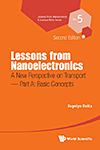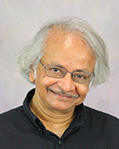Fundamentals of Current Flow
Category
Published on
Abstract
 Everyone is familiar with the amazing performance of a modern smartphone, powered by a billion-plus nanotransistors, each having an active region that is barely a few hundred atoms long. The same amazing technology has also led to a deeper understanding of the nature of current flow and heat dissipation on an atomic scale which is of broad relevance to the general problems of non-equilibrium statistical mechanics that pervade many different fields.
Everyone is familiar with the amazing performance of a modern smartphone, powered by a billion-plus nanotransistors, each having an active region that is barely a few hundred atoms long. The same amazing technology has also led to a deeper understanding of the nature of current flow and heat dissipation on an atomic scale which is of broad relevance to the general problems of non-equilibrium statistical mechanics that pervade many different fields.
This book is based on a set of two online courses originally offered in 2012 on nanoHUB-U and more recently in 2015 on edX. In preparing the second edition the author decided to split it into parts A and B titled Basic Concepts and Quantum Transport respectively, along the lines of the two courses. A list of available video lectures corresponding to different sections of this volume is provided upfront.
The corresponding online course for this text can be found at Fundamentals of Nanoelectronics, Part A : Basic Concepts, 2nd Edition.
To make these lectures accessible to anyone in any branch of science or engineering, the author assume very little background beyond linear algebra and differential equations. However, the author will be discussing advanced concepts that should be of interest even to specialists, who are encouraged to look at his earlier books for additional technical details.
This is a draft copy of a set of lecture notes titled Lessons from Nanoelectronics: Part A. Basic Concepts and published by World Scientific and distributed with their permission. Copyright World Scientific Publishing Company, 2018.
Volumes in this series are available from World Scientific Publishing Company http://www.worldscientific.com/series/lnlns
Bio
 Supriyo Datta received his B.Tech. from the Indian Institute of Technology in Kharagpur, India in 1975 and his Ph.D. from the University of Illinois at Urbana-Champaign in 1979. In 1981, he joined Purdue University, where he is (since 1999) the Thomas Duncan Distinguished Professor in the School of Electrical and Computer Engineering. He started his career in the field of ultrasonics and was selected by the Ultrasonics group as its outstanding young engineer to receive an IEEE Centennial Key to the Future Award and by the ASEE to receive the Terman Award for his book on Surface Acoustic Wave Devices.
Supriyo Datta received his B.Tech. from the Indian Institute of Technology in Kharagpur, India in 1975 and his Ph.D. from the University of Illinois at Urbana-Champaign in 1979. In 1981, he joined Purdue University, where he is (since 1999) the Thomas Duncan Distinguished Professor in the School of Electrical and Computer Engineering. He started his career in the field of ultrasonics and was selected by the Ultrasonics group as its outstanding young engineer to receive an IEEE Centennial Key to the Future Award and by the ASEE to receive the Terman Award for his book on Surface Acoustic Wave Devices.
Since 1985 he has focused on current flow in nanoscale electronic devices and the approach pioneered by his group for the description of quantum transport, combining the non-equilibrium Green function (NEGF) formalism of many-body physics with the Landauer formalism from mesoscopic physics, has been widely adopted in the field of nanoelectronics. This is described in his books Electronic Transport in Mesoscopic Systems (Cambridge 1995) and Quantum Transport: Atom to Transistor (Cambridge 2005) and he was elected to the US National Academy of Engineering (NAE) for this work.
Datta is also well-known for his contributions to spin electronics and molecular electronics. He has received Technical Field Awards from the IEEE both for research and for graduate teaching and was selected by Sigma Xi to receive the Procter Prize.
Cite this work
Researchers should cite this work as follows:
-
Datta, Supriyo. A New Perspective on Transport—Part A: Basic Concepts. 2nd edition, (Lessons from Nanoscience: A Lecture Notes Series: Vol. 5). World Scientific Publishing Company, 2018. https://doi.org/10.1142/10440-vol1